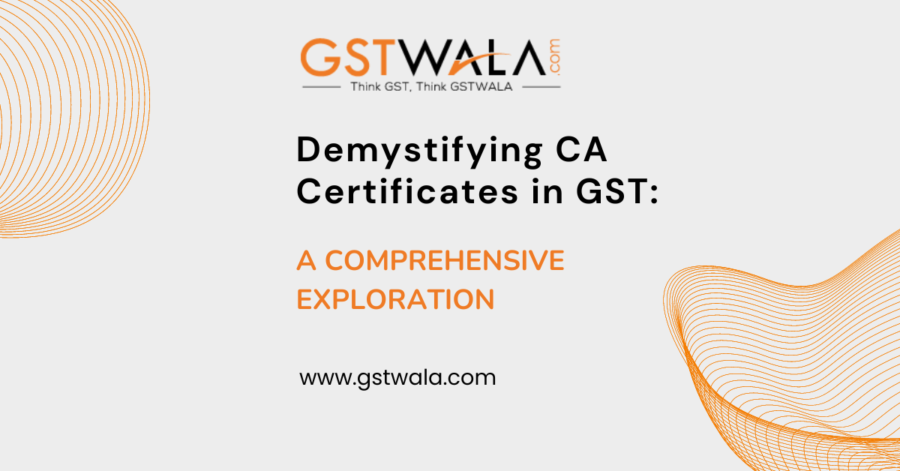
Demystifying CA Certificates in GST: A Comprehensive Exploration
The issuance of Circular No. 183/15/2022-GST by the Indirect Taxes Committee (IDTC) of the Institute of Chartered Accountants of India (ICAI) has sparked considerable discussion within the realm of Goods and Services Tax (GST). This circular has prompted debates regarding its validity and the far-reaching implications it holds, particularly concerning the certification process undertaken by Chartered Accountants (CAs) and Cost Accountants (CMAs). In this comprehensive guide, we embark on a detailed journey through the intricate landscape of CA certificates in GST, aiming to provide clarity and insights into its nuances and implications.
Validity Concerns and Disputes:
The issuance of Circular No. 183/15/2022-GST, dated 27th December 2022, has raised pertinent questions regarding its validity and legal foundation within the CGST Act. Moreover, concerns have been raised regarding the validity of 2A and the doctrine of impossibility under section 16(2)(c). These validity concerns persist, casting a shadow of uncertainty, particularly until 31st December 2021, further complicating matters for taxpayers and practitioners alike.
Understanding CA Certificates:
- Purpose and Scope:
CA certificates in the realm of GST transcend mere documentation; they are the products of meticulous audit procedures aimed at providing assurance regarding the discharge of tax liabilities by taxpayers. However, certifying tax compliance necessitates continuous monitoring of monthly and annual compliances, extending beyond the confines of the relevant financial year.
- Key Categories for Certification:
The Circular delineates specific mismatch categories for which CA certificates are mandated. These categories include instances such as non-filing of GSTR-1 but filing GSTR-3B, omission of outward supplies in GSTR-1 but filing GSTR-3B, incorrect reporting of supplies in GSTR-1, and reporting incorrect GSTIN in GSTR-1.
- Threshold for Certification:
CAs are directed to issue certificates when the mismatched input tax credit exceeds Rs. 5 lakhs, with specified limits for IGST, CGST, and SGST/UTGST mismatches.
- Verification Process:
The verification process entails a meticulous scrutiny of various documents, including tax invoices, books, annual returns (GSTR-9), and reconciliation statements (GSTR-9C). It is imperative to exclude mismatches resolved through methods other than GSTR-3B and to assess mismatches spanning multiple tax periods.
- Ensuring Compliance:
Practitioners must pay close attention to the tax periods concerning the issuance of tax invoices, reporting of outward supplies, and discharge of output tax. Additionally, they should acknowledge that mismatches may extend beyond the categories specified in the Circular, necessitating a comprehensive approach to compliance.
Challenges and Considerations:
- Fee Structure:
Professionals must carefully consider whether the fees for certification align with the complexity and effort involved, especially considering the limited outcome for taxpayers.
- Representation in Disputes:
A nuanced dilemma arises concerning whether a CA issuing a certificate for ITC mismatch can represent the recipient in disputes challenging section 16(2)(c) without certification, underscoring the complexities inherent in the certification process.
- Evaluating Each Case:
The issuance of certificates should be approached with caution, necessitating a thorough evaluation on a case-by-case basis. Professionals must consider the intricacies and complexities involved before committing to certification, ensuring diligence and discretion in their endeavors.
Sample Certificate for Input Tax Credit Mismatch:
The certificate issued by CAs/CNAs holds significant importance in verifying the compliance of taxpayers with GST regulations. Here’s a breakdown of its components and responsibilities:
- Applicant Details:
- The certificate includes detailed information regarding the applicant, supplier, and recipient, along with references to relevant circulars and regulations.
- Supplier Management Responsibilities:
- The management of the supplier bears the responsibility of maintaining accurate records and ensuring compliance with Section 16(2)(c) of the CGST Act.
- Practitioner’s Responsibility:
- CAs/CNAs are tasked with verifying that the tax on supplies covered by mismatched invoices has been duly paid by the supplier.
- Opinion and Conclusion:
- The certificate provides an opinion based on the practitioner’s examination and verification, outlining the tax payments made by the supplier.
Navigating the complexities of GST certification necessitates a profound understanding of regulations and meticulous attention to detail. While Circular No. 183/15/2022-GST provides guidelines, practitioners must exercise diligence and discretion in issuing certificates. By comprehensively understanding CA certificates in GST, businesses can ensure compliance and effectively mitigate risks, thereby fostering a culture of accountability and transparency within the GST framework.
For personalized GST solutions tailored to your business needs,
reach out to us at info@gstwala.com
